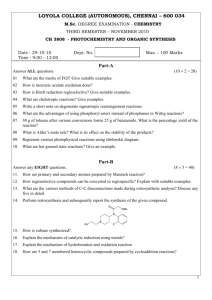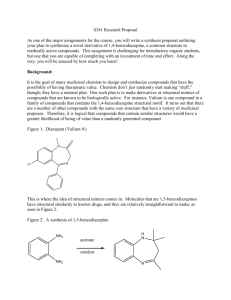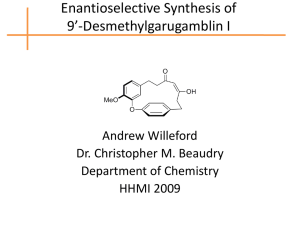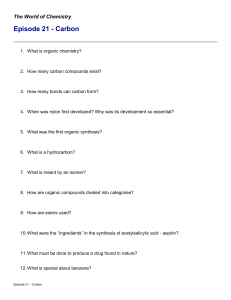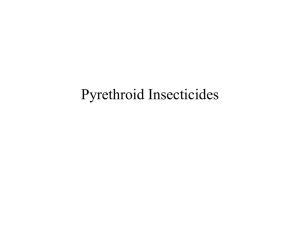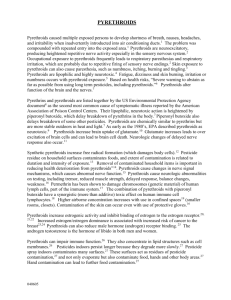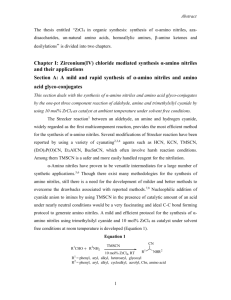Microsoft Word
advertisement
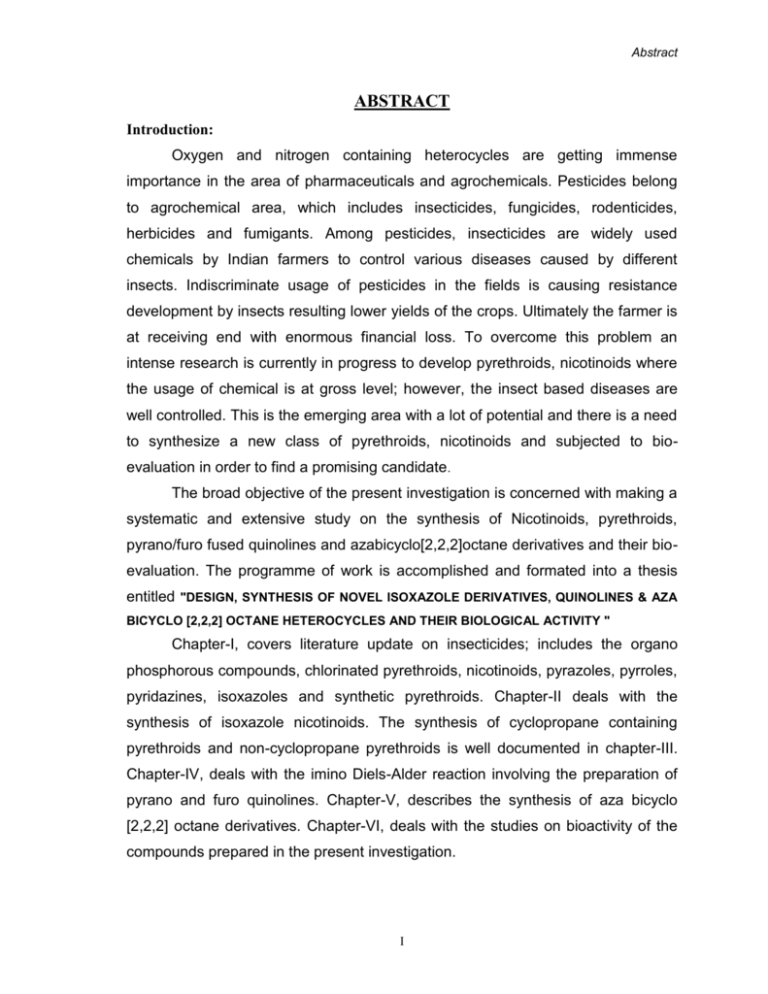
Abstract ABSTRACT Introduction: Oxygen and nitrogen containing heterocycles are getting immense importance in the area of pharmaceuticals and agrochemicals. Pesticides belong to agrochemical area, which includes insecticides, fungicides, rodenticides, herbicides and fumigants. Among pesticides, insecticides are widely used chemicals by Indian farmers to control various diseases caused by different insects. Indiscriminate usage of pesticides in the fields is causing resistance development by insects resulting lower yields of the crops. Ultimately the farmer is at receiving end with enormous financial loss. To overcome this problem an intense research is currently in progress to develop pyrethroids, nicotinoids where the usage of chemical is at gross level; however, the insect based diseases are well controlled. This is the emerging area with a lot of potential and there is a need to synthesize a new class of pyrethroids, nicotinoids and subjected to bioevaluation in order to find a promising candidate. The broad objective of the present investigation is concerned with making a systematic and extensive study on the synthesis of Nicotinoids, pyrethroids, pyrano/furo fused quinolines and azabicyclo[2,2,2]octane derivatives and their bioevaluation. The programme of work is accomplished and formated into a thesis entitled "DESIGN, SYNTHESIS OF NOVEL ISOXAZOLE DERIVATIVES, QUINOLINES & AZA BICYCLO [2,2,2] OCTANE HETEROCYCLES AND THEIR BIOLOGICAL ACTIVITY " Chapter-I, covers literature update on insecticides; includes the organo phosphorous compounds, chlorinated pyrethroids, nicotinoids, pyrazoles, pyrroles, pyridazines, isoxazoles and synthetic pyrethroids. Chapter-II deals with the synthesis of isoxazole nicotinoids. The synthesis of cyclopropane containing pyrethroids and non-cyclopropane pyrethroids is well documented in chapter-III. Chapter-IV, deals with the imino Diels-Alder reaction involving the preparation of pyrano and furo quinolines. Chapter-V, describes the synthesis of aza bicyclo [2,2,2] octane derivatives. Chapter-VI, deals with the studies on bioactivity of the compounds prepared in the present investigation. I Abstract The research work covered under each chapter has been briefly outlined below. CHAPTER-I Insecticides belong to pesticides and their application is mainly to target pests/insects harmful to various crops and mankind. They include organochlorines, organophosphates, carbamates, pyrethroids, nicotinoids and various heterocycles like pyrazoles, pyrroles, quinazolines etc,. A detailed literature coverage of earlier and existing insecticides is described in this chapter. Some of the commercially well known products are outlined below. H Cl C Cl O H3C Cl H3CO C Cl Cl P O C C O CONHCH 3 NHCH 3 O OCH 3 DDT H Monocrotophos N Cl N O Cl O carbaryl NO 2 H N F O NH O CN Cypermethrin Cl F N Imidacloprid H N Cl O Diflubenzuron CHAPTER II Synthesis of isoxazole Neo-nicotinoids: The present chapter demonstrates the synthesis of isoxazole containing new heterocyclic compounds and tests their insecticidal activity. The salient feature of our strategy involves initial conversion of acetophenones into methyl 5-phenyl substituted isoxazole-3-carboxylate using dimethyloxalate, hydroxylaminehydrogensulphate in methanol. The isoxazole ester is further transformed into alcohol and then converted to chloride. The chloro fragment is coupled with the other moiety 2-nitroimineimidazole to obtain novel II Abstract insecticidal heterocyclic compounds. The structure of the compounds are well characterized by the spectroscopic methods like IR, 1HNMR, 13C NMR, Mass, elemental analysis and also by X-ray analysis. The details of the strategy adopted to synthesise novel heterocyclic compounds are given in Scheme 1. In order to generalize and show the versatility of the reaction, different substituted acetophenones are prepared and tested for the reactions and they underwent smooth transformation to give final products in quantitative yields. O O COOMe CH 3 COOMe R O N COOMe (NH2-OH)2 H2SO4 R R NaOMe MeOH 1 (a-k) O MeOH COOMe 2 (a-k) NaBH4 THF AlCl3 Reflux O CH2Cl R K2CO3 HN Acetonitrile CsCl O O N NH N 4 (a-k) N SOCl2, DMF heptane 0 65-80 C CH2OH R 3 (a-k) NO 2 N N R NH N 5(a-k) NO2 a = H, b = 4-Cl, c = 4-Br, d = 4-F, e = 4-CH3, f = 4-OCH3, g = 4-Isobutyl, h = 3-OCH3, i = 3-Cl, j = 2-OCH3, k = 2-Cl Scheme 1 CHAPTER III The synthesis of cyclopropane containing isoxazoles and non-cyclopropane isoxazoles retaining the active functional groups like dimethyls at C 2 and stereochemistry at C3 positions is well documented in chapter-III. The completed work is conveniently divided into two sections. III Abstract Section A: Synthesis of new series of cyclopropane pyrethroids: The present work is initiated with the condensation of optically pure cyclopropane containing acid fragment with the heterocycle moiety containing alcohol similar to cypermethrine and cyhalothrin. The synthon (methyl 5-phenyl substituted isoxazole-3-carboxylate) which was prepared and covered in chapter II is utilized further and converted to aldehyde (2) using sodium bis(2methoxyethoxy)aluminum hydride (Red-Al) at -70˚C in toluene. The other moiety, optically pure acid part is converted into acid chloride using thionyl chloride in hexane. The acid chloride (3/4) and aldehyde was coupled via insitu generation of cyanohydrin by using NaCN and DABCO as PTC in dichloroethane and target molecule is obtained. The coupling product is obtained in diastereomeric pairs, which could not be separated by column chromatography. The details of reaction is depicted in scheme 2. In order to study the versatility of the above series of reactions, we have synthesized various aldehydes by changing the constituent R groups and prepared a series of new molecules. They are tested for larvicidal activity. O N COOMe R O Red-Al in Toluene Toluene, -70 0C N CHO R 1 2 NaCN, 0-5 0C, 'R DABCO ''R Dichloroethane, water N 'R ''R O CN 3. R' = R'' = Cl (cypermethric acid) 4. R' = Cl, R'' = CF3 (cyhalothric acid) R = H, 4-CH3, 4-F, 4-OCH3, 4-Cl, 2-OCH3, 2-Cl, 3-OCH3, 3-Cl IV O 3 and 4 O O 5 and 6 Scheme 2 Cl R Abstract Section B: Synthesis of non-cyclopropane pyrethroids: In continuation of our studies on structure modifications in the alcohol moiety of pyrethroids 5 [(R,S)Cyano(5-aryl-3-isoxazole)methyl(1R)-cis-3-(2,2-dichlorovinyl) 2,2-dimethyl cyclopropanecarboxylate] and 6 [(R,S)Cyano(5-aryl-3-isoxazole) methyl(1R)-cis-3-(2-chloro-3,3,3-trifluro-1-propenyl)-2,2-dimethylcyclopropane-1car boxylate] as discussed in the section A of chapter-III, we have adopted alternate strategies to achieve the final target molecule of noncyclopropane isoxazoles. The S-acid [(2S)-2-(4-chlorophenyl)-3-methylbutanoicacid] is converted into acid chloride (7) and treated with aldehyde and obtained desired product (8) in good yield (scheme 3). All the compounds prepared in this section are screened for their activity. O N COOMe R O Red-Al in Toluene Toluene, -70 0C N CHO R 1 2 Cl NaCN, 0-5 0C, DABCO Cl Dichloroethane, water N O 7 O O Cl CN O R 8 R = H, 4-CH3, 4-F, 4-OCH3, 4-Cl, 2-OCH3, 2-Cl, 3-OCH3, 3-Cl Scheme 3 CHAPTER IV Zirconium tetrachloride mediated imino Diels-Alder Reactions: Synthesis of pyrano and furo [3,2-c] quinolines. Natural products containing pyrano and furoquinoline moieties are widely distributed in nature and found to be associated with a wide range of biological activities such as psychotropic, antiallergic, anti-inflammatory, estrogenic activities. Hence, efforts are directed towards the synthesis of these compounds by imino V Abstract Diels-Alder reaction catalyzed by a Lewis acid from N-benzylideneanilines and nucleophilic olefins. We have used ZrCl4 as a green catalyst for imino Diels-Alder reaction and reported here for the first time. Here we describe the synthesis and characterization of mono and disubstituted pyrano and furoquinolines 3, 4, 6, 7, 8, 9, 10, 11 and 12, 13 for the first time by the application of the imino Diels-Alder reaction using ZrCl4 as a new catalyst. This procedure is simple, efficient and has general application for the synthesis of pyrano and furo [3,2-c] quinolines starting from respective Nbenzylideneanilines as dienes and 3,4-dihydro-2H-pyran (DHP) or 2,3- dihydrofuran (DHF) as dienophiles to yield pyrano or furo quinolines respectively. Reaction of N-benzylideneanilines (1a-k) with DHP or DHF in the presence of ZrCl4 (10 mol%) in DCM at ambient temperature resulted in the formation of endo (3a-k) and exo (4a-k) pyrano and furoquinolines in 72-97% yield 9 R R N O ZrCl4 , RT [ ]n CH2Cl2 60-180 min + 1 O 7 HN 10b 4a R O1 H HN + 10b 2 4a 3 [ ] n 5 H H R' 2 H 7 2 [ ] 3 n 5 10 8 H 1 H n=0 n=1 R' 9 10 8 R' 3 4 Scheme 4 The structures of the final products are characterized by IR, ׀H NMR, 13C NMR, Mass spectroscopic data, elemental analysis and X-ray crystallography studies. Interestingly, the di-substituted 3-chloro-4-fluoro-N-benzylideneaniline (5) and DHP (2a) under the present reaction conditions yielded four isomers 6, 8, 10, and 12 in the ratio 50: 15: 18: 17 respectively in an overall yield of 69% (Scheme 5) containing a large excess of the endo isomer. It is for the first time that all four isomers are isolated in pure state from the reaction mixture by column chromatography and characterized unequivocally by VI ׀H NMR spectra and Abstract reported. As observed in the case of DHP, DHF (2b) also acted as a good dienophile in reaction with 3-chloro-4-fluoro-N-bezylideneaniline (5) to obtain the expected mixture of four isomers in the ratio of 60: 12: 17: 11 in 93% yield. All the four compounds (7, 9, 11, 13) are new and the structures assigned are in consonance with the ׀HNMR spectra. F F Cl Cl H H O O HN H H [ ]n HN H H [ ]n F Cl O + N [ ]n ZrCl4 (10 mol%) CH2Cl2 , RT 90-180 min 6 (n=1) 7 (n=0) 8 (n=1) 9 (n=0) F F 5 Cl H Cl H n=1 (a) n=0 (b) O O HN 2 H H [ ]n 10 (n=1) 11 (n=0) HN H H [ ]n 12 (n=1) 13 (n=0) Scheme 5 It is noteworthy to mention that exo and endo isomers (6, 7, 8, 9, 10, 11, 12, 13) of compounds are reported for the first time and the structures unambiguously assigned using IR, ׀HNMR, 13CNMR, Mass spectroscopic data, elemental analysis and X-ray crystallography. In order to generalize and show the versatility of the reaction, different substituted imines are prepared and condensed with DHP and DHF to obtain diastereomerically pure final products in quantitative yields. VII Abstract CHAPTER V Zirconiumtetrachloride mediated imino Diels-Alder Reactions: Synthesis of aza bicyclo [2, 2, 2] octane derivatives. (imine acting as dienophile): The imino Diels-Alder reaction has emerged as a powerful tool for the synthesis of nitrogen containing heterocycles. In the present chapter the use of cyclic α, β-unsaturated ketone (cyclohexene-2-one) as diene in imino Diels-Alder reaction catalyzed by zirconium tetrachloride furnished cycloaddition products. N-benzylideneanilines, prepared according to the reported procedure, reacted with cyclohexene-2-one in the presence of zirconium tetrachloride (10 mol%) in dichloromethane at ambient temperature, resulted in the formation of new compounds 3a, 4a, 5a in the ratio 45: 2: 18 respectively in an overall yield of 65% (scheme 6). The compounds 3a, 4a, 5a are unequivocally characterized by 1D and 2D NMR spectroscopic techniques, including HSQC and HMBC analysis. R' O R N R R ZrCl4 (10 mol%) + N CH2Cl 2 , RT , 6Hrs R' + N R' 2 R 3 a-e + N O R' R 1a-e R' 4 a-e N O R' 5 a-e Scheme 6 Unlike 1a-e, when imine 1f-g derived from benzyl amine, is used as substrate (scheme 7) in presence of ZrCl4 (10 mol %), the reaction proceeded smoothly at ambient temperature to furnish exclusively a single product 4f-g in 30-35% yield Table 1 (entry f-g). These products are new and characterized by spectroscopic data (IR, 1HNMR, 13CNMR, MS). VIII Abstract R R R' O N ZrCl4 (10 mol%) + N CH2Cl 2 , RT , 8Hrs O R' R' 4 f-g 1 f-g Scheme 7 A probable reaction mechanism is depicted in scheme 8 OH Ph N + Ar Ph Ar HN H Ph N Ar N Ar N O H Ar Ph Ph O 5a H Ph Ar N Ar O 4a H3O+ H Ph N Ar Ar N Ph 3a Scheme 8 In order to generalize and show the versatility of the reaction, different substituted imines are prepared and tested for the above mentioned reactions and they underwent smooth transformation to give final products in quantitative yields. The reaction of imine with cyclopentenone in presence of ZrCl4 found that there is no product formation. IX Abstract CHAPTER VI The compounds prepared in chapter II, III, IV and V are subjected to activity screening and some of the compounds showed promising activity against fourth instar larvae of Culex quinquefasciatus and tetrahydroquinolines have been tested for anti bacterial activity using Bacillus subtilis, Psudomonas aeruginosa, Aspergillus niger, Alternaria radicinia as test species Conclusion: The research programme covered in this thesis is demonstrated to synthesize well targeted molecules adopting various strategies and each compound is screened for activity in order to find its potency to identify a lead molecule, which is prone to become a drug. X
